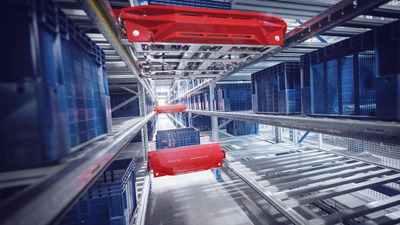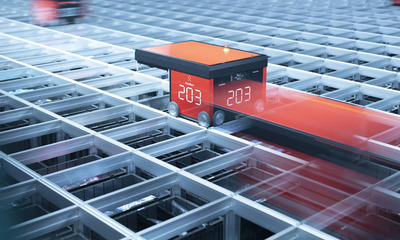How to choose the right ASRS
By Dan Ulmamei, Managing Director, Swisslog Australia and New Zealand
Tuesday, 16 September, 2025

Every square foot of a warehouse or distribution centre comes at a premium, especially near highly populated urban areas. Logistics operations also face growing pressures to move more items, more quickly.
An automated storage and retrieval system (ASRS) addresses both challenges by optimising available space in a facility while enabling fast, accurate access to stored items. These advanced warehouse solutions can optimise and manage everything from fully loaded pallets to cartons, bins and individual items.
ASRS solutions come in many configurations, which can make it challenging to determine the best option. This article will cover what they are, their most common types, and how to determine which ASRS is right for your operation.
What is an ASRS?
ASRS solutions offer dynamic and space-saving forms of automated storage and inventory management. They also offer many distinct advantages to distribution, fulfilment and logistics operations:
-
Greater storage density — ASRS solutions use mechanised storage and retrieval machines (SRMs) or shuttles to transport, store and retrieve items. This allows more items to be stored in a given footprint by reducing the space required to access products. In addition, these systems maximise vertical capacity and can sometimes make use of unusually shaped areas. Movements are coordinated by a warehouse management software (WMS) or warehouse control system (WCS), which tracks inventory and uses advanced algorithms to further optimise storage.
-
Increased picking accuracy — When an item is needed, the WCS knows where to find it, minimising the risk of human error. An SRM or shuttle is routed to the precise location and retrieves the appropriate pallet, tote, carton or bin.
-
Higher warehouse throughput — The WCS manages item movement and storage locations to minimise travel and congestion throughout the system, ensuring rapid delivery to goods-to-person (GTP) stations or other destinations. For example, high-demand items are often stored in multiple locations closer to retrieval points.
-
Enhanced worker safety and efficiency — Warehouse associates are relieved of arduous, repetitive and unproductive tasks, including long walks and retrieving items from high or low shelves. This frees workers to focus on higher-value physical and mental tasks that are more challenging to automate. It also reduces the need for forklifts, one of the most common causes of warehouse injuries.
-
Scalability — Many ASRS solutions are modular, enabling expansion as your operation grows.
- Less product damage and loss — ASRS solutions can store items at heights and depths impractical for manual handling and are often enclosed, protecting products from dust, dirt, impacts and theft.
Characteristics of ASRS solutions
Although every ASRS shares certain basic components — storage racks or structures, SRMs and control systems — the similarities end there. Their different types can be classified into three broad categories based on the size and weight of the items they manage.
- Unit load systems handle large, heavy items. They’re most commonly used to store fully loaded pallets, but can also manage bulky items like furniture, large appliances, car bodies and even boats. They require robust, high-capacity SRMs and racking systems capable of supporting pallet weights of up to 3500 kg.
- Mini load systems are optimised for medium-sized items weighing usually up to around 250 kg. Speed and efficiency are the key priorities for these systems, which store items in totes, trays, cartons or bins. They typically use narrow aisles and racks or a cube storage architecture to maximise space utilisation and often employ cranes to retrieve items.
- Micro load systems are designed for the smallest and lightest items, generally 45 kg or less. They utilise more compact storage rack structures that eliminate the need for building columns and allow more flexible system layouts. Some feature extractor mechanisms optimised to handle smaller items.

Four main types of ASRS technologies
The four most common types of ASRS solutions are as follows:
Stacker cranes
Stacker cranes operate in very narrow aisles, stowing and retrieving items at heights up to 50 m. These rail-guided systems travel through aisles and use vertical lift carriages equipped with telescopic or container loaders to stow and retrieve items. Depending on the storage density and throughput requirements of your warehouse, they can handle multiple loads in single, double and multi-deep storage.
Ideal for retrofitting, stacker cranes can be installed quickly. They can be found in heavy-duty unit load systems such as automated pallet warehouses. They’re also used in mini load applications to handle cartons, totes or trays in ledger angle or shelf racks.
Shuttle systems
Shuttles are autonomous storage vehicles that move independently on the crossbeams of multi-level storage racks. Each level of each lane has its own shuttle, which works in conjunction with a vertical lift to quickly store and retrieve items. This optimises storage space by enabling deep, dense racks with narrow lanes. They can be used for bins, cases, trays or pallet applications.
Storage shuttle systems are scalable ASRS technologies that offer some of the highest throughput rates. They’re used in storage solutions of every size. One example is CycloneCarrier, which is designed for fast, efficient handling of small loads.
Robotic cube storage
Robotic cube storage systems, such as AutoStore, offer maximum storage density for small loads and bins and the highest order fulfilment per square foot of any ASRS solution — over 20,000 picks per hour. These systems combine an aluminium grid with specialised bins that can be stacked on top of each other. Robots travel on rails at the top of the grid, using lifting straps and a gripper plate to retrieve the required totes from the grid.
AutoStore can be optimally designed in and around structures such as columns, floor height differences or other space challenges. In addition, it can now handle multi-temperature facilities.
AMR-based storage
A different ASRS for small loads, AMR-based storage uses a swarm of autonomous mobile robots (AMRs) to transport mobile racks to workstations for picking. This strategy reduces worker travel and error rates, and can be used in combination with technologies like pick-to-light.
Unlike other forms of most ASRS, AMR-based systems such as Swisslog CarryPick don’t require any major changes to your building and can be implemented in just a few months. There are no fixed racks, lifts or conveyors, making the system flexible enough to move, change or expand as needed.

How to choose the right ASRS
Selecting the optimal ASRS solution requires a multi-dimensional assessment that aligns operational goals with technical feasibility. The decision should be guided by the following key factors:
1. Product characteristics
- Load type: Whether you’re handling pallets, totes, cartons or bins, the ASRS must be compatible with the physical dimensions, weight and handling requirements of your goods.
- SKU diversity: High SKU variability may favour flexible systems like shuttle-based or crane-based ASRS, while low-SKU, high-volume operations may benefit from deep-lane pallet systems.
2. Warehouse layout and space utilisation
- Ceiling height: High-bay warehouses can leverage vertical space with stacker crane systems like Vectura for pallets or Tornado for light goods storage.
- Footprint constraints: Compact systems like PowerStore or multi-deep configurations can maximise storage density in tight spaces for pallet storage or CycloneCarrier for light goods.
- Flow design: Consider how goods move in and out — whether you need single or dual access points, and how ASRS integrates with conveyors ProMove or QuickMove, AMRs like IntraMove, or manual zones.
3. Throughput requirements
- Speed and volume: High-throughput environments (eg, retail distribution) may require shuttle systems or multi-crane set-ups to meet demand.
- Peak vs average load: Systems should be sized for peak loads without over-investing in idle capacity.
4. Storage density
- Utilisation rates: Aim for >90% rack utilisation, factoring in SKU mix, expiry dates and batch handling. A solution can be multi-deep pallet stacker crane solutions or shuttle systems.
5. Cost considerations
- CapEx vs OpEx: Evaluate total cost of ownership, including installation, maintenance, energy consumption and software licensing.
- Scalability: Modular systems allow phased investments and future expansion without major redesigns.
6. Environmental conditions
- Temperature zones: Systems must be engineered for ambient, chilled or deep-freeze environments, with appropriate materials, insulation and heating for moving parts.
- Energy efficiency: Besides the cost factor, the CO2 impact of systems should be considered.
7. Software integration
- WMS/WCS compatibility: Seamless integration with platforms like SynQ or SAP EWM ensures real-time inventory tracking and system orchestration.
- Fleet and load management: Advanced software enables dynamic slotting, load balancing and predictive maintenance.
Conclusion
There’s no substitute for consulting with an experienced expert when choosing an ASRS. In addition to the system itself, you’ll need to consider how it integrates with your facility, industry and processes, including picking, replenishment, packout and/or shipping. Swisslog automation specialists are available worldwide to help you determine the best ASRS solution for your supply chain requirements, facility and budget.
Six beverage trends predicted for 2026
Demand for customisation, 'protein-ification' and sustainable storytelling are some of...
Making UHT processing less intensive on energy
A nutritional beverages company was seeking a more sustainable way to produce UHT beverages using...
Tasty twist for chocolate alternatives
Food scientists develop two novel flavour-boosting techniques to transform carob pulp into a...











